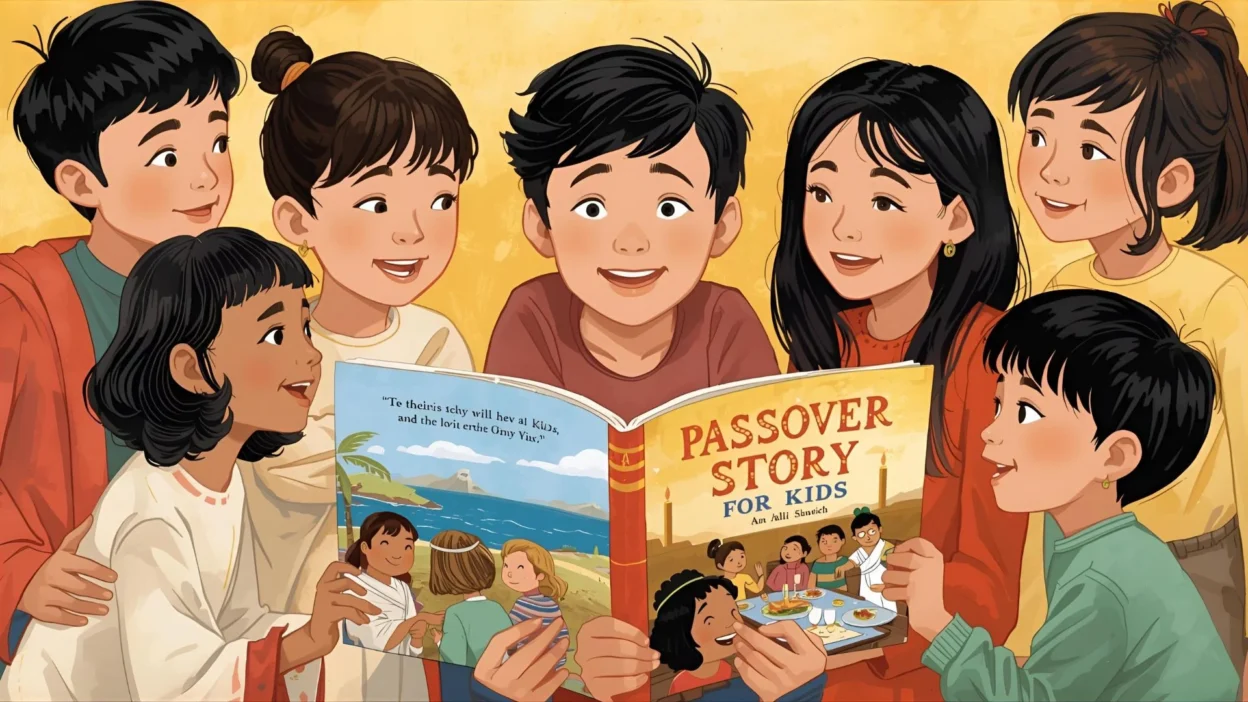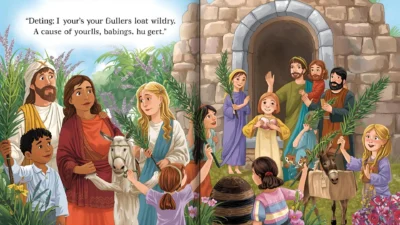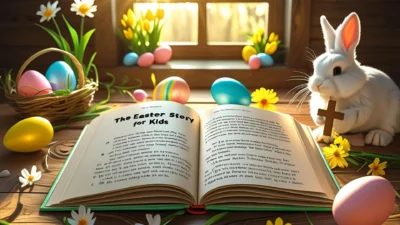Passover is a beautiful holiday celebrated in Jewish tradition, and it holds important lessons for kids and families. That’s why today we’re bringing you the best, trending, and hot Passover story for kids collection for 2025.
Whether you’re searching for the Passover story for kids, a short Passover story for kids, a Jewish Passover story for kids, or even a Passover story for kids printable, video, or PowerPoint, these stories are crafted to be engaging, simple, and full of meaning.
Perfect for parents, teachers, or anyone who wants to share faith-based lessons in a fun way, these stories can also be used in classrooms, bedtime reading, or storytelling circles. Let’s dive into the first three!
Story 1: The Baby in the Basket
Long ago, in Egypt, a kind woman named Yocheved gave birth to a baby boy. But Pharaoh, the ruler of Egypt, had made a cruel law: every baby boy born to the Israelites must be taken away. Afraid but determined to save her child, Yocheved gently placed the baby in a woven basket and set him afloat on the Nile River.
The baby drifted down the river until Pharaoh’s daughter spotted the basket. Curious, she opened it and saw the tiny baby crying. Her heart filled with love, and she decided to raise him as her own. She named him Moses.
Moses grew up in Pharaoh’s palace, safe and strong. Though he was raised as an Egyptian prince, he never forgot his roots. Later in life, Moses would lead the Israelites out of Egypt, starting the great story of Passover.
Moral: Even small acts of courage can lead to great miracles.
Story 2: The Burning Bush
Moses, now grown, lived far from Egypt. One day while tending sheep, he noticed something unusual: a bush on fire that didn’t burn up. He stepped closer, and suddenly a voice called his name—“Moses, Moses!”
It was God speaking. God told Moses that He had seen the suffering of the Israelites and wanted Moses to lead them out of Egypt. Moses felt afraid and unsure. “Who am I to lead such a mission?” he asked.
But God reassured him: “I will be with you.” With faith and bravery, Moses agreed, marking the beginning of the Israelites’ journey to freedom.
Moral: When we feel weak, faith gives us strength to do great things.
Story 3: The Ten Plagues
Moses returned to Pharaoh and asked, “Let my people go!” But Pharaoh refused. To show His power, God sent ten plagues upon Egypt: rivers turned to blood, frogs filled the land, locusts swarmed, and finally, the firstborn in each Egyptian household died.
Still, the Israelites were safe. God told them to mark their doors with lamb’s blood so the angel of death would “pass over” their homes. That night, Pharaoh finally gave in and told the Israelites to leave.
This marked the beginning of their journey to freedom, celebrated every year as Passover.
Moral: Freedom is worth fighting for, and faith helps us endure hardships.
Story 4: Crossing the Red Sea
When Pharaoh let the Israelites leave Egypt, the people cheered with joy. They packed their belongings quickly and began their journey into the desert. But Pharaoh soon changed his mind. He sent his soldiers and chariots to bring them back.
The Israelites grew frightened when they reached the Red Sea. Water stretched far ahead, and Pharaoh’s army thundered behind. They cried out to Moses, “Why did you bring us here to die?”
Moses, calm and faithful, raised his staff as God commanded. Suddenly, the sea split into two towering walls of water, and a dry path appeared between them. The Israelites hurried across, amazed at the miracle.
Pharaoh’s army chased them, but when the last Israelite stepped safely onto shore, the sea closed over the soldiers. The Israelites were free! They sang and danced with joy, praising God for His mighty power.
Moral: With faith, impossible paths can open before us.
Story 5: The Matzah Bread
As the Israelites prepared to leave Egypt, they were in a hurry. There was no time to let their bread dough rise. Instead, they baked flat, unleavened bread called matzah.
This simple bread became a special symbol of freedom and remembrance. Even today, during Passover, Jewish families eat matzah to honor that night. Parents tell their children, “We eat matzah because our ancestors had to leave quickly.”
The crunchy bread reminds everyone that freedom is precious and must be cherished. It also teaches that sometimes, simple things carry the greatest meaning.
At their Seder tables, families share matzah with songs, prayers, and stories, keeping the memory of Passover alive for each new generation.
Moral: Simple things can hold powerful lessons when shared with love.
Story 6: Miriam’s Song
After crossing the Red Sea, the Israelites felt relief and joy. Among them was Miriam, Moses’ sister. She picked up a tambourine and began to sing.
“Sing to God,” Miriam cried, “for He has triumphed gloriously!” Other women joined her, dancing and shaking tambourines. Their music echoed across the desert, lifting spirits and filling hearts with gratitude.
Miriam’s song reminded everyone that freedom is not only about escape but also about celebrating life. Even after hardship, music and joy give strength to continue forward.
From then on, Miriam was remembered as a leader who encouraged hope and celebration through song.
Moral: Music and joy help us celebrate freedom and strengthen our hearts.
Story 7: The Pillar of Cloud and Fire
As the Israelites traveled through the desert, they often felt lost and unsure of where to go. But God did not leave them alone. During the day, He sent a pillar of cloud to guide their steps. At night, a pillar of fire lit the way so they could continue safely.
The people marveled at these miracles. The cloud shaded them from the hot desert sun, and the fire warmed and protected them during the cold nights. Whenever the cloud moved, they packed their tents and followed. Whenever it stopped, they rested.
The pillars reminded them that God was always with them, leading them to the Promised Land. Even in their fear, they knew they were never alone.
Moral: With guidance and faith, we can find our way even in the darkest times.
Story 8: The First Passover Meal
Before the final plague, God gave the Israelites important instructions. Each family was to prepare a lamb, roast it, and eat it with bitter herbs and unleavened bread. They were to mark their doors with the lamb’s blood so the angel of death would “pass over” their homes.
That night, the Israelites gathered together in small groups, carefully following God’s words. Children listened closely as parents explained the meaning of the meal: the lamb for protection, the herbs for bitterness of slavery, and the bread for their haste to freedom.
This first Passover meal became a tradition, passed down through generations. Today, families around the world still gather for the Passover Seder, retelling the story with food, prayer, and song.
Moral: Traditions keep history alive and teach future generations the meaning of freedom.
Story 9: The Golden Calf Lesson
After leaving Egypt, Moses climbed Mount Sinai to receive God’s commandments. But while he was gone, the Israelites grew restless. They asked Aaron, Moses’ brother, to make them an idol. Aaron crafted a golden calf, and the people began to worship it.
When Moses returned, he was heartbroken. He reminded them that God had freed them from slavery and deserved their faith, not a statue. The people realized their mistake, repented, and turned back to God.
This story is often told during Passover to remind children and adults alike that freedom also requires responsibility and loyalty.
Moral: True freedom comes with responsibility and faithfulness to what is right.
Story 10: The Ten Commandments
On Mount Sinai, Moses received two stone tablets engraved with God’s commandments. These Ten Commandments became the foundation of the Israelites’ way of life. They taught lessons about worship, kindness, respect, and justice.
The Israelites gathered at the foot of the mountain as Moses shared God’s words. Even children listened, knowing these rules would shape their future. From honoring parents to speaking truthfully, the commandments offered guidance for living in freedom with fairness and love.
The story of the Ten Commandments is often linked to Passover because it shows how freedom is not just escape from slavery, but also living with values that protect everyone.
Moral: Freedom lasts when it is guided by values of love, justice, and respect.
✨ Conclusion
These ten Passover stories for kids—from the baby Moses in the basket to the Ten Commandments—offer timeless lessons of faith, freedom, courage, and hope.
Whether you’re sharing a short Passover story for kids, downloading a Passover story for kids printable, watching a Passover story for kids video, or using a Passover story for kids PowerPoint, each tale keeps the Jewish Passover story for kids alive for the next generation.
Through storytelling, traditions, and celebration, Passover remains one of the most meaningful holidays to teach children about resilience, responsibility, and the joy of freedom.




